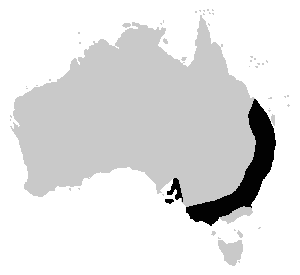Bibron's toadlet facts for kids
Quick facts for kids Bibron's toadlet |
|
|---|---|
 |
|
| Conservation status | |
| Scientific classification | |
 |
|
| Range of the Bibron's toadlet |
The Bibron's toadlet (Pseudophryne bibronii), also known as the brown toadlet, is a small frog that lives on the ground in Australia. Even though its numbers have gone down in some places, you can still find it across much of New South Wales, Victoria, south-eastern Queensland, and eastern South Australia. This includes Kangaroo Island.
Contents
What Does the Bibron's Toadlet Look Like?
This toadlet can look a bit different depending on where it lives. It grows to about 30 millimeters (about 1.2 inches) long. Its back is usually brown, grey, or black. Sometimes it has small red spots.
Its belly is often a mix of black and white, like a marble pattern. In some areas, this pattern might be very light. A special feature is an orange, red, or yellow patch found in its armpits. The color of this patch can change from yellow to orange. For example, in the Jervis Bay area, this patch is always yellow. This might be because it sometimes mixes with another type of toadlet called the Dendy's toadlet, which has a bright yellow armpit patch. There is also a yellow or orange patch or a small raised bump on the back of its thigh.
Where Do Bibron's Toadlets Live and What Do They Do?
Bibron's toadlets like to live in places that get flooded after it rains. These areas can be different kinds of places. They might live in swamps near the coast, next to creeks, or in temporary ponds. You can also find them in ditches along roads in forests. They live in open land, heathland, and even in areas high up in the mountains.
When a Bibron's toadlet feels threatened, it has a clever trick. It will often lie on its back and pretend to be dead. It won't move or respond to anything. This act can last for as long as an hour!
How Do Bibron's Toadlets Have Babies?
Male Bibron's toadlets try to attract females by making a rough "ark" sound. They hide in mud, under rocks, or in damp leaves when they call. They usually call after heavy rain or when there is water around. They can call all year, but mostly from February to June. They even call when the temperature is as low as 4 degrees Celsius (about 39 degrees Fahrenheit).
Female Bibron's toadlets are special because they mate with several males. A female might visit up to eight different males. She mates with each one and lays her eggs in the small nest he has dug. After laying eggs, the female moves on. The male then stays to take care of the nest.
The nest might have wet leaves or moss inside. When it rains, the nest fills with water. The eggs then hatch, and the tiny tadpoles grow in the water. If it doesn't rain enough soon after the eggs are laid, the eggs can stay unhatched for many weeks. The tadpoles will still be developing inside the eggs. The nest must stay wet to keep the eggs moist. But it can't be too wet, or the eggs might get washed away. Female frogs that mate with more males and lay eggs in more nests have a better chance of some of their young surviving.
See also
 In Spanish: Pseudophryne bibronii para niños
In Spanish: Pseudophryne bibronii para niños


